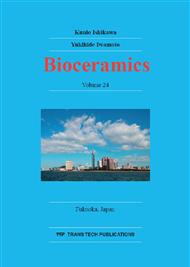[1]
J.B. Howard, J.T. McKinnon, Y. Makarovsky, A.L. Lafleur, M.E. Johnson, Fullerenes C60 and C70 in flames, Nature. 6331 (1991) 139-141.
DOI: 10.1038/352139a0
Google Scholar
[2]
Z. Markovic, V. Trajkovic, Biomedical potential of the reactive oxygen species generation and quenching by fullerenes (C60), Biomaterials. 29 (2008) 3561-2573.
DOI: 10.1016/j.biomaterials.2008.05.005
Google Scholar
[3]
A.G. Cuenca, H. Jiang, S.N. Hochwald, M. Delano, W.G. Cance, S.R. Grobmyer, Emerging implications of nanotechnology on cancer di-agnostics and therapeutics, Cancer 107 (2006) 459-466.
DOI: 10.1002/cncr.22035
Google Scholar
[4]
S. Bosi, T. Da Ros, G. Spalluto, M. Prato, Fullerene derivatives: an attractive tool for biological applications, Eur. J. Med. Chem. 38 (2003) 913-923.
DOI: 10.1016/j.ejmech.2003.09.005
Google Scholar
[5]
T. Tsuchiya, I. Oguri, Y.N. Yamakoshi, N. Miyata, Novel harmful effects of.
Google Scholar
[60]
fullerene on mouse embryos in vitro and in vivo. FEBS Lett, 393 (1996) 139-145.
Google Scholar
[6]
N. Sera, H. Tokiwa, N. Miyata, Mutagenicity of the fullerene C60-generated singlet oxygen dependent formation of lipid peroxides, Carcinogenesis. 17 (1996) 2163-2169.
DOI: 10.1093/carcin/17.10.2163
Google Scholar
[7]
J.P. Kamat, T.P. Devasagayam, K.I. Priyadarsini, H. Mohan, J.P. Mittal, Oxidative damage induced by the fullerene C60 on photosensitization in rat liver microsomes, Chem. Biol. Interact. 114 (1998) 145-159.
DOI: 10.1016/s0009-2797(98)00047-7
Google Scholar
[8]
G. Bogdanović, V. Kojić, A. Dordević, J. Canadanović-Brunet, M. Vojinović-Miloradov, V.V. Baltić, Modulating activity of fullerol C60(OH)22 on doxorubicin-induced cytotoxicity, Toxicol. In Vitro. 18 (2004) 629-637.
DOI: 10.1016/j.tiv.2004.02.010
Google Scholar
[9]
H. Yamawaki, N. Iwai, Cytotoxicity of water-soluble fullerene in vascular endothelial cells, Am. J. Physiol. Cell Physiol. 290 (2006) C1495-1502.
DOI: 10.1152/ajpcell.00481.2005
Google Scholar
[10]
A. Isakovic, Z. Markovic, B. Todorovic-Markovic, N. Nikolic, S. Vranjes-Djuric, M. Mirkovic, M. Dramicanin, L. Harhaji, N. Raicevic, Z. Nikolic, V. Trajkovic, Distinct cytotoxic mechanisms of pristine versus hydroxylated fullerene, Toxicol. Sci. 91 (2006).
DOI: 10.1093/toxsci/kfj127
Google Scholar
[11]
J. Kolosnjaj, H. Szwarc, F. Moussa, Toxicity studies of fullerenes and derivatives, Adv. Exp. Med. Biol. 620 (2007) 168-180.
DOI: 10.1007/978-0-387-76713-0_13
Google Scholar
[12]
B. Han, M.N. Karim, Cytotoxicity of aggregated fullerene C60 particles on CHO and MDCK cells, Scanning. 30 (2008) 213-220.
DOI: 10.1002/sca.20081
Google Scholar
[13]
H. Spielmann, I. Pohl, B. Doering, M. Liebsch, F. Moldenhauer, The embryonic stem cell test (EST), an in vitro embryotoxicity test using two permanent mouse cell lines: 3T3 fibro-blasts and embryonic stem cells, In vitro Toxicol. 10 (1997).
DOI: 10.1007/978-3-7091-7500-2_69
Google Scholar
[14]
K. Imai, H. Spielmann H, G. Scholz G, I Pohl, M. Nakamura, In vitro embryotoxicity testing of embryonic stem cells into contracting cardiac myocytes, AATEX 6 (2000) 153-154.
Google Scholar
[15]
K. Imai, H. Spielmann H, G. Scholz G, I Pohl, M. Nakamura, In vitro embryotoxicity testing of polymeric substances for dental use by dif-ferentation of embryonic stem cells, AATEX 8 (2001) 31-39.
Google Scholar
[16]
K. Imai, M. Nakamura, Use of an alternative for whole animal experiments: determining embryotoxicity of dental biomaterials by differentiation of ES cells, Nippon Yakurigaku Zasshi 125 (2005) 335-342.
Google Scholar
[17]
K. Imai, M. Nakamura, In vitro embryotoxicity testing of metals for dental use by differentiation of embryonic stem cell test, Congenital Anomalies 46 (2006) 34-38.
DOI: 10.1111/j.1741-4520.2006.00099.x
Google Scholar
[18]
K. Imai, T. Hayakawa, M. Nakamura, Evaluation of in vitro embryotoxicity of dental monomers by differentiation of embryonic stem cells into contracting cardiac myocytes, AATEX 12 (2007) 171-178.
Google Scholar
[19]
K. Imai, S. Kusakawa, A. Tanoue, M. Kuwagata, M. Senuma M, M. Furuya, H. Takashima, An attempt to cell recovery factor in cell differ-entiation culture with the embryonic stem cell test (EST), J Oral Tissue Engin. 6 (2009) 152-158.
Google Scholar
[20]
K. Imai, K. Suese, T. Akasaka, F. Watari, S. Takeda S, In vitro study of cell differentiation by mouse embryo stem cells on nanocarbon tubes, Nano Biomed 2 (2010) 47-51.
DOI: 10.1016/j.apsusc.2012.01.150
Google Scholar
[21]
K Imai, S. Takeda, A. Tanoue, K. Nakamura, K. Suese, F. Watari, H. Takashima. An attempt to cell differentiation in three-dimensional culture system using non-feeder ES-D3 cells and feeder layer type ES cells, J Oral Tissue Engin. 8 (2011).
Google Scholar
[22]
K. Imai, T. Akasaka, F. Watari, A. Tanoue A, K. Nakamura, K. Suese, T. Takashima, F. Watari, T. Nishikawa, A. Tanaka, S. Takeda, Study of in vitro embryotoxicity potential by two type nano titanium dioxide, Nano Biomed. 3 (2011) 224-230.
DOI: 10.1016/j.apsusc.2012.01.150
Google Scholar
[23]
K. Imai, F. Watari, T. Nishikawa, A. Tanaka, A. tanoue, K. Nakamura, H. Takashima, An attempt to study of the C60 fullerene on differentiation of mouse ES cells, Nano Biomed. 3(2011) 288-293.
Google Scholar
[24]
M.J. Evans, M.H. Kaufmann, Establishment in culture of pluripotential cells from mouse embryos, Nature 292 (1981) 154-156.
DOI: 10.1038/292154a0
Google Scholar
[25]
H. Spielmann H, I. Pohl, B. Doering, F. Moldenhauer, In vitro embryotoxicity assay using two permanent cell lines: mouse embryonic stem cells and 3T3 fibroblasts. Abstracts of the 23. ETS conference 1995, Dublin; Teratology 51 (1995) 31A-32A.
DOI: 10.1007/978-3-7091-7500-2_69
Google Scholar
[26]
G. Scholz, E. Genschow, I. Pohl, S. Bremer, M. Paparella, H. Raabe, F. Moldenhauer, J. Southee, H. Spielmann, Prevalidation of the embryonic stem cell test (EST), a new in vitro embryotoxicity test, Toxicology in Vitro 13 (1999) 675-681.
DOI: 10.1016/s0887-2333(99)00046-6
Google Scholar
[27]
H. Spielmann, E. Genschow, N.A. Brown, A.H. Piersma, A. Verhoef, M.Q. Spanjersberg, H. Huuskonen, F. Paillard, A. Seiler, Validation of the rat limb bud micromass test in the international ECVAM validation study on three in vitro embryotoxicity tests, Altern. Lab. Anim. 32 (2004).
DOI: 10.1177/026119290403200306
Google Scholar
[28]
H. Spielmann, A. Seiler, S. Bremer, L. Hareng, T. Hartung, H. Ahr, E. Faustman, U. Haas, G.J. Moffat, H. Nau, P. Vanparys, A. Piersma, J.R. Sintes, J. Stuart. The practical application of three validated in vitro embryotoxicity tests. The report and recommendations of an ECVAM/ZEBET workshop (ECVAM work-shop 57), Altern. Lab. Anim. 34 (2006).
DOI: 10.1177/026119290603400504
Google Scholar


